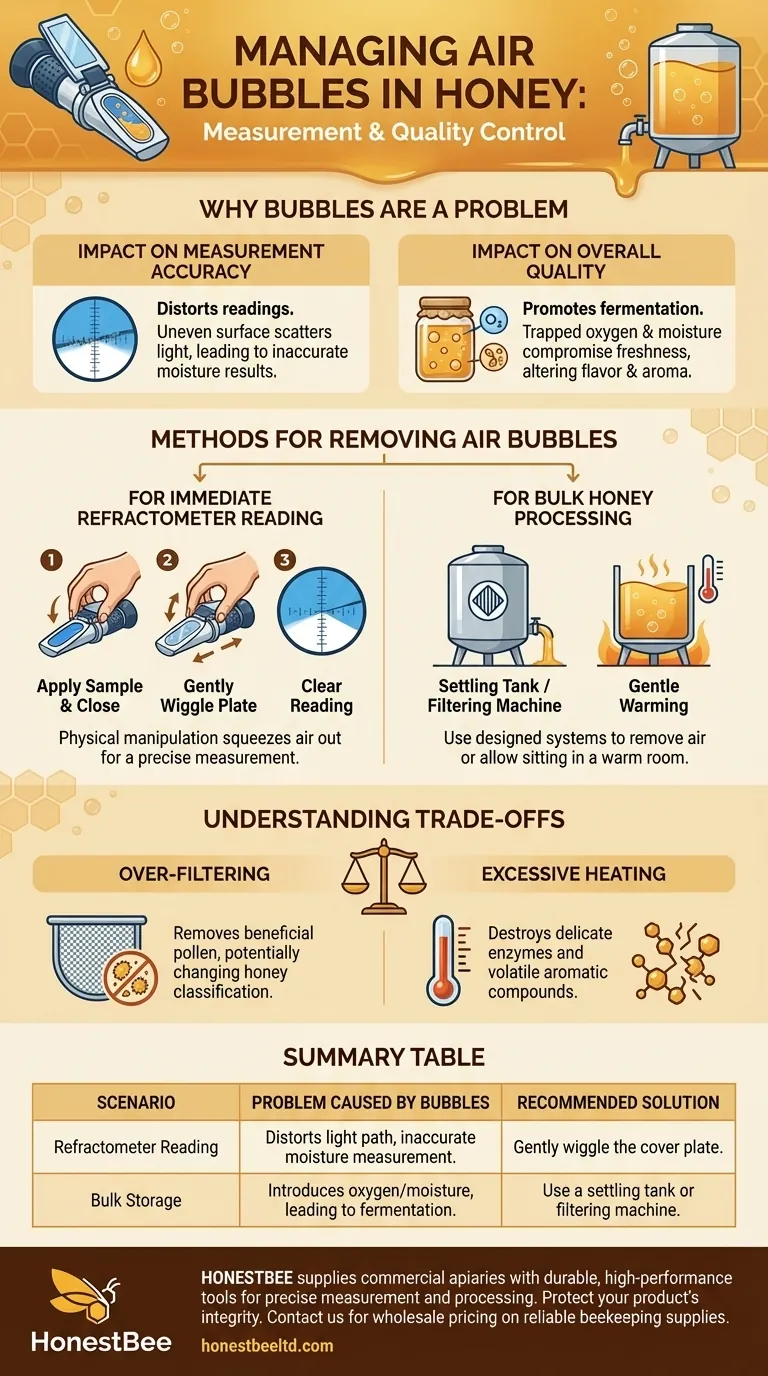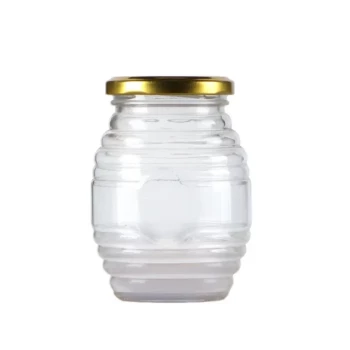To remove air bubbles from a honey sample on a refractometer, you should gently wiggle the device's cover panel after applying the sample. This simple action is often enough to force the bubbles out from the viewing area, ensuring an accurate and clear reading.
The presence of air bubbles is a critical issue at two different scales: for measurement, they distort instrument readings, and for storage, they can degrade the honey's overall quality and freshness over time.

Why Air Bubbles Are a Problem
Air bubbles might seem minor, but they interfere with honey at both a physical and a chemical level. Understanding their impact is key to proper handling.
Impact on Measurement Accuracy
When measuring honey's moisture content with a refractometer, a clean, uniform layer of honey is essential for an accurate result.
Air bubbles disrupt this uniformity. They create an uneven surface that scatters light, leading to a blurry or distorted reading on the measurement scale.
Popping these bubbles by gently moving the cover plate ensures the light passes cleanly through the honey, giving you a precise and reliable measurement.
Impact on Overall Honey Quality
In bulk honey, trapped air bubbles introduce oxygen and moisture, which can compromise the product during storage.
These elements can promote the growth of yeast, leading to fermentation. This process alters the honey's flavor, aroma, and chemical composition.
Removing air that gets incorporated during extraction and processing is a standard practice for maintaining the honey's freshness and preventing spoilage.
Methods for Removing Air Bubbles
The correct method for removing air bubbles depends entirely on your immediate goal, whether it's taking a quick reading or preparing honey for bottling.
For an Immediate Refractometer Reading
The most direct solution is physical manipulation. After placing a drop of honey on the prism, close the cover plate.
If you see bubbles, gently press and wiggle the plate back and forth. This pressure squeezes the air out to the edges, leaving a clear sample for measurement.
For Bulk Honey Processing
For larger volumes, a honey filtering machine or a settling tank is used. These systems are designed to remove air and other particulates incorporated during extraction.
Allowing honey to sit in a warm room can also help, as the reduced viscosity lets bubbles rise to the surface more easily where they can be skimmed off.
Understanding the Trade-offs
While removing bubbles is important, the method you choose has consequences. It's crucial to balance purity with preservation of quality.
Over-Filtering
Using extremely fine filters can remove not just bubbles and debris, but also beneficial pollen grains. Many consumers value pollen for its potential health benefits, and its absence can change the honey's classification.
Excessive Heating
Gently warming honey makes it less viscous and helps release bubbles, but overheating is detrimental. High temperatures can destroy the delicate enzymes and volatile aromatic compounds that give raw honey its unique character and health properties.
Making the Right Choice for Your Goal
Your approach to dealing with air bubbles should be directly tied to your objective.
- If your primary focus is getting an accurate moisture reading: Gently wiggling the refractometer's cover plate is the fastest and most effective solution.
- If your primary focus is preparing honey for long-term storage or sale: Employing a proper settling or filtering system is necessary to prevent fermentation and preserve freshness.
Ultimately, managing air bubbles correctly is a crucial step in both analyzing and maintaining the integrity of your honey.
Summary Table:
| Scenario | Problem Caused by Bubbles | Recommended Solution |
|---|---|---|
| Refractometer Reading | Distorts light path, causing inaccurate moisture measurement. | Gently wiggle the cover plate to squeeze bubbles out. |
| Bulk Storage | Introduces oxygen/moisture, leading to fermentation and spoilage. | Use a settling tank or honey filtering machine. |
Struggling with honey quality control? Air bubbles are just one challenge. HONESTBEE supplies commercial apiaries and beekeeping equipment distributors with the durable, high-performance tools needed for precise measurement and efficient processing—from refractometers to filtering systems. Let us help you protect your product's integrity and your bottom line.
Contact HONESTBEE today for wholesale pricing on reliable beekeeping supplies.
Visual Guide

Related Products
- HONESTBEE 3-Frame Manual Acrylic Honey Extractor
- HONESTBEE 72 Frame Industrial Electric Honey Extractor for Beekeeping
- 8-Frame Electric Self-Reversing Honey Extractor Spinner for Commercial Honey Extraction Equipment
- 24 Frame Honey Extractor Commercial Radial Honey Frame Extraction Machine
- Commercial 48-Frame Stainless Steel Honey Extractor
People Also Ask
- What machines are needed in beekeeping besides basic tools? Scale Your Honey Harvest Efficiently
- How do you collect honey at home? A Beginner's Guide to Harvesting from Your Hive
- How to extract honey by hand? A Guide to Crush & Strain vs. Manual Extractors
- What is a fun and easy alternative to using a honey extractor for harvesting honey? Try the Crush and Strain Method
- What equipment is used for honey harvest? Essential Tools for Every Beekeeper



















